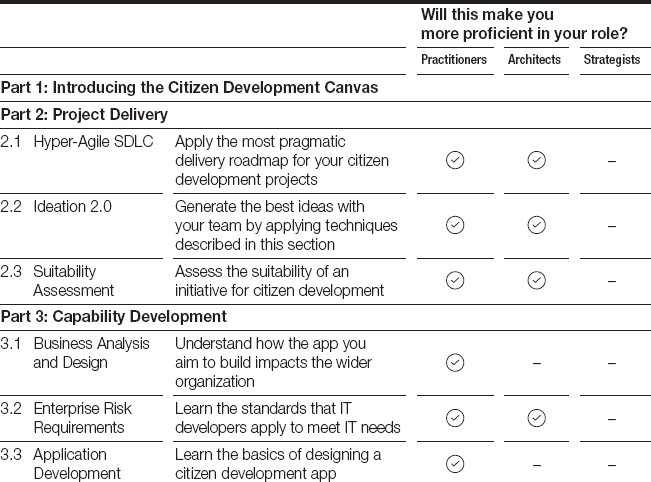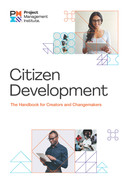Citizen Development Canvas
The Citizen Development Canvas (Figure 1) is the PMI framework describing the five major components that allow an organization to successfully build business apps, operate, and scale citizen development across an organization.

The Citizen Development Canvas framework redefines how we think about application development and software delivery.
| DID YOU KNOW? |
Historically made from tightly woven hemp, the word canvas comes from the Latin cannabis—it came into common usage in the 16th century during the Italian Renaissance (Stewart, 2018).
For citizen developers, the speed at which applications can be designed, built, and deployed requires a new framework to help citizen developers safely and securely build better apps. Enterprise risk requirements and application development can now occur as a single integrated activity, giving rise to a substantial shortening of the design-build time frames and empowering the end user with the tools to bring ideas to life. This eliminates the need for business and functional requirements as a way of creating standardized documentation between the business and functional design teams. The Project Delivery component contains a new software delivery life cycle (Hyper-Agile SDLC), building upon the principles of agile delivery. Now many simple, yet powerful, citizen development apps can be designed, built, and deployed without the need for software engineering teams and technical architects. More complex, enterprise-wide citizen development apps do require integration with other systems and IT custom development to extend functionality. IT developers get to do more technically challenging work while citizen developers can create apps to deliver solutions to problems that might otherwise be seen as lower priority. Guidance is provided within the Project Delivery and Capability Development components to equip the citizen developer with the details and concepts to handle the responsibility that comes with the additional authority they need to create powerful apps.
Citizen developer architects manage citizen developers. Citizen developer architects understand how to get the most from their squads. They know how to create the space within the organization to protect their squads and manage the politics, which gives them the resources and operating environment necessary to succeed in their organization. This requires power skills (the ability to be adaptable, creative, and influential), a solid understanding of operating model concepts, and the ability to manage complex stakeholders through organizational alignment concepts and practices.
Citizen developer practitioners will benefit from understanding the basics of the maturity model. They have a critical role in helping the organization adopt citizen development in the early stages of maturity at the discovery phase. By delivering apps that demonstrate the value potential at a local level in their business, they sow the seeds for growing citizen development in their organizations.
Citizen developer practitioners will be tested to manage the maturing of citizen development in any organization, and many of the topics we talk about in the maturity model will fall into the responsibility of both architect and strategist roles.
Citizen development's potential to deliver more than pockets of value requires the skillful management of organizational politics. The level of management required differs from one organization to another and from one industry to another. Change occurs slowly in established, slow-moving environments or heavily regulated environments, and is generally more challenging to affect. In these environments, the skeptic may challenge the value, and many managers may feel threatened by the risk of empowering lower-level and highly capable individuals who seek autonomy and have a desire to put their ideas into practice. These managers need skills such as the power of persuasion to navigate organizational hierarchy. This will test any seasoned change manager.
The ability to move citizen development beyond the discovery phase into experimentation brings a requirement to understand organizational design and change management. While we recognize that most organizations are different, we map out the journey of citizen development maturity into five stages and provide guidance to identify which stages an organization is at and a series of next best actions.
Our canvas includes a five-stage maturity model that allows organizations to assess, diagnose, and remedy obstacles or identify actions to help them pursue an effective citizen developer strategy. A concerted citizen development strategy at scale requires unique structures, tools, processes, and practices embedded in the organization to enable value delivery through citizen development. The maturity model stages are Discovery, Experimentation, Adoption, Scaling, and Innovating.
The book is organized into six parts, outlined in Table 2.
Any citizen developer will benefit from reading the entire book regardless of the previous knowledge they possess on each of the topics. On the right-hand side of the table, we highlight which parts of the book will help practitioners, architects, and strategists to perform their job better. This is aligned with the colors in the Citizen Development Canvas (Figure 1).


